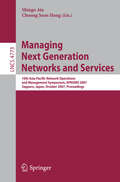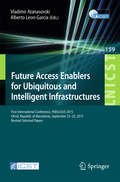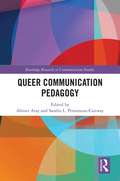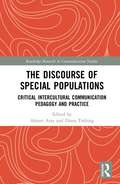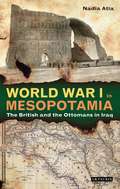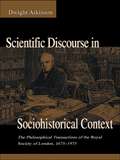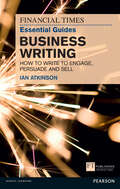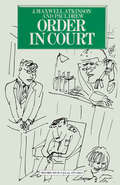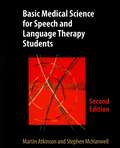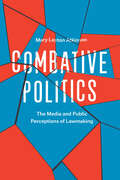- Table View
- List View
Managing Next Generation Networks and Services: 10th Asia-Pacific Network Operations and Management Symposium, APNOMS 2007, Sapporo, Japan, October 10-12, 2007, Proceedings (Lecture Notes in Computer Science #4773)
by Shingo Ata Choong Seon HongThis book constitutes the refereed proceedings of the 9th Asia-Pacific Network Operations and Management Symposium, APNOMS 2007, held in Sapporo, Japan, October 2007. The 48 revised full papers and 30 revised short papers cover management of distributed networks, network configuration and planning, network security management, sensor and ad-hoc networks, network monitoring, routing and traffic engineering, management of wireless networks and security on wireless networks.
Molecular Communications and Nanonetworks: From Nature To Practical Systems
by Barış AtakanThis book will introduce the concept of molecular communications and nanonetworks. The publication addresses why nanoscale communication is needed for the sophisticated nano and biotechnology applications. The text introduces the frontier applications of the molecular communication and nanonetworks. The book examines the molecular communication types called active, passive, and gap junction molecular communications. The author presents the molecular transmitter, receiver, encoding and decoding mechanisms used in these systems. Discussing the molecular communication system model and looking at the unique characteristics of practical molecular communication systems and these chemical reactions and their effects on the communication performance. Finally, the book examines the point-to-point, broadcast, and multiple-access molecular channel and shows two promising application examples of the nanonetworks. The first application example is the body area nanonetworks used in nanomedicine. the second nanonetwork application example, i.e., NanoSensor Networks (NSNs) with Molecular Communication.
Future Access Enablers for Ubiquitous and Intelligent Infrastructures: First International Conference, FABULOUS 2015, Ohrid, Republic of Macedonia, September 23-25, 2015. Revised Selected Papers (Lecture Notes of the Institute for Computer Sciences, Social Informatics and Telecommunications Engineering #159)
by Vladimir Atanasovski Alberto Leon-GarciaThis book constitutes the proceedings of the First International Conference on Future Access Enablers for Ubiquitous and Intelligent Infrastructures, FABULOUS 2015, held in Ohrid, Republic of Macedonia, in September 2015.The 39 revised papers cover the broad areas of future wireless networks, ambient and assisted living, smart infrastructures and security and reflect the fast developing and vibrant penetration of IoT technologies in diverse areas of human live.
Energy Detection for Spectrum Sensing in Cognitive Radio (SpringerBriefs in Computer Science)
by Saman Atapattu Chintha Tellambura Hai JiangThis Springer Brief focuses on the current state-of-the-art research on spectrum sensing by using energy detection, a low-complexity and low-cost technique. It includes a comprehensive summary of recent research, fundamental theories, possible architectures, useful performance measurements of energy detection and applications of energy detection. Concise, practical chapters explore conventional energy detectors, alternative forms of energy detectors, performance measurements, diversity techniques and cooperative networks. The careful analysis enables reader to identify the most efficient techniques for improving energy detection performance. Energy Detection for Spectrum Sensing in Cognitive Radio is a valuable tool for researchers and practitioners interested in spectrum sensing and cognitive radio networks. Advanced-level students studying wireless communication will also benefit from this brief.
Mediated Intercultural Communication in a Digital Age (Routledge Research in Communication Studies)
by Ahmet Atay Margaret U. D’SilvaThis book focuses on mediated intercultural communication in the context of globalization. Analyzing social and traditional media using qualitative, interpretive, and critical and cultural perspectives, contributors engage with diverse topics - ranging from hybrid identities in different communities, to journalistic collaborations in the global media landscape. In addition, the authors also examine the placeless and borderless communities of diaspora members, their transnational identities, and the social media stories that shape and are shaped by them.
Mediated Intercultural Communication in a Digital Age (Routledge Research in Communication Studies)
by Ahmet Atay Margaret U. D'SilvaThis book focuses on mediated intercultural communication in the context of globalization. Analyzing social and traditional media using qualitative, interpretive, and critical and cultural perspectives, contributors engage with diverse topics - ranging from hybrid identities in different communities, to journalistic collaborations in the global media landscape. In addition, the authors also examine the placeless and borderless communities of diaspora members, their transnational identities, and the social media stories that shape and are shaped by them.
Queer Communication Pedagogy (Routledge Research in Communication Studies)
by Ahmet Atay Sandra L. Pensoneau-ConwayThis book addresses queer issues and current events from a communication perspective to articulate a queer communication pedagogy. Through putting communication pedagogy and queer studies into dialogue, the book investigates how queer theory and critical communication pedagogy intersect in pedagogical spaces. The chapters identify institutional and educational barriers, oppressions, and issues pertaining to queer lives in the context of higher education. Using a variety of critical methodological approaches (including dialogic methods, autoethnography, performative writing, and visual methods), each chapter theorizes a queer communication pedagogy, and offers a path toward and innovative ideas about materializing queer communication pedagogy as a disciplinary endeavor. This book will be of interest to scholars, graduate students, and upper-level undergraduate students in Communication Studies, Critical Communication Pedagogy, Intercultural Communication, Higher Education, Public Pedagogy, and Queer Studies, and Critical/Cultural Studies.
Queer Communication Pedagogy (Routledge Research in Communication Studies)
by Ahmet Atay Sandra L. Pensoneau-ConwayThis book addresses queer issues and current events from a communication perspective to articulate a queer communication pedagogy. Through putting communication pedagogy and queer studies into dialogue, the book investigates how queer theory and critical communication pedagogy intersect in pedagogical spaces. The chapters identify institutional and educational barriers, oppressions, and issues pertaining to queer lives in the context of higher education. Using a variety of critical methodological approaches (including dialogic methods, autoethnography, performative writing, and visual methods), each chapter theorizes a queer communication pedagogy, and offers a path toward and innovative ideas about materializing queer communication pedagogy as a disciplinary endeavor. This book will be of interest to scholars, graduate students, and upper-level undergraduate students in Communication Studies, Critical Communication Pedagogy, Intercultural Communication, Higher Education, Public Pedagogy, and Queer Studies, and Critical/Cultural Studies.
The Discourse of Special Populations: Critical Intercultural Communication Pedagogy and Practice (Routledge Research in Communication Studies)
by Ahmet Atay Diana TrebingThe term "special population" occupies a particular purpose and has a particular role in the discourse of higher education. This book uses the term as an umbrella term for any student who tends to be underrepresented on college campuses and has a very specific set of unique needs: among others, individuals with physical and learning disabilities, international students, ethnic minorities, LGBTQ students, single parents, and first generation and other non-traditional student groups. Sometimes these "special" student groups are visible to educators; however, quite often they are hidden in plain sight, which makes it difficult for educators to work effectively and meaningfully with these student groups. This book uses the framework of critical intercultural communication pedagogy to generate a discussion about pedagogical issues surrounding students who are categorized as "special populations", focusing on culturally sensitive pedagogical methods to educate all students.
New Directions in Wireless Communications Systems: From Mobile to 5G
by Athanasios G. Kanatas, Konstantina S. Nikita and Panagiotis MathiopoulosBeyond 2020, wireless communication systems will have to support more than 1,000 times the traffic volume of today's systems. This extremely high traffic load is a major issue faced by 5G designers and researchers. This challenge will be met by a combination of parallel techniques that will use more spectrum more flexibly, realize higher spectral efficiency, and densify cells. Novel techniques and paradigms must be developed to meet these goals. The book addresses diverse key-point issues of next-generation wireless communications systems and identifies promising solutions. The book's core is concentrated to techniques and methods belonging to what is generally called radio access network.
Social Media Strategy: A Practical Guide to Social Media Marketing and Customer Engagement
by Julie AthertonSocial Media Strategy provides a simple, structured way to create integrated customer engagement and social media campaigns that work. Organizations often talk of digital planning but struggle to know which channels to invest in, how to integrate them with content marketing activity, or fail to develop measurable outputs that align with business objectives. This book provides a clear road map for efficient planning, deliverance and financial accountability of social media's contribution to the business.Social Media Strategy delivers practical guidance such as identifying and targeting audience segments, methods of two-way community engagement, reputation management, being present on the right channels, and driving action through influencers. It also identifies the relevant tools and platforms to audit, track and measure business impact and customer engagement. With example templates, interviews and global case studies including National Geographic, TUI, Dreams Beds and Tiny Giant, this professional guide delivers a long-term solution for maximizing social media led business development.
Social Media Strategy: A Practical Guide to Social Media Marketing and Customer Engagement
by Julie AthertonSocial Media Strategy provides a simple, structured way to create integrated customer engagement and social media campaigns that work. Organizations often talk of digital planning but struggle to know which channels to invest in, how to integrate them with content marketing activity, or fail to develop measurable outputs that align with business objectives. This book provides a clear road map for efficient planning, deliverance and financial accountability of social media's contribution to the business.Social Media Strategy delivers practical guidance such as identifying and targeting audience segments, methods of two-way community engagement, reputation management, being present on the right channels, and driving action through influencers. It also identifies the relevant tools and platforms to audit, track and measure business impact and customer engagement. With example templates, interviews and global case studies including National Geographic, TUI, Dreams Beds and Tiny Giant, this professional guide delivers a long-term solution for maximizing social media led business development.
Protest Technologies and Media Revolutions: The Longue Durée (Digital Activism And Society: Politics, Economy And Culture In Network Communication)
by Athina Karatzogianni,Michael Schandorf and Ioanna FerraContains an Open Access chapter. Protest Technologies and Media Revolutions portrays the critical role of mass connection in the success of any movement, resurrection, protest, and revolution. The communication mechanisms for this connection have, at times, evolved and elsewhere undergone revolutions of their own. Authors debate this relationship, and the strategies and lessons of 'connecting to the masses' considering the development of media, technology and communication strategies over the last century. Key topics covered include revolution, communication, protest and technology, spanning from the Russian Revolution to the present day. The discussion is not limited to historic cases of technology and revolution, nor to contemporary ones. The book, therefore, generates a debate about how art, media and communication technologies have been operationalized to connect, mobilize and organize, in different historical times, and in diverse national, political, and socio-economic contexts.
World War I in Mesopotamia: The British and the Ottomans in Iraq (Library Of Middle East History Ser.)
by Nadia AtiaThe Punjab region of India sent more than 600,000 combatants to assist the British war effort during World War I. Their families back home, thousands of miles from the major scenes of battle, were desperate for war news, and newspapers provided daily reports to keep the local population up-to-date with developments on the Western Front. This book presents the first English-language translations of hundreds of articles published during World War I in the newsapers of the Punjab region. They offer a lens into the anxieties and aspirations of Punjabis, a population that committed resources, food, labour as well as combatants to the British war effort. Amidst a steadily growing field of studies on World War I that examine the effects of the war on colonial populations, War News in India makes a unique and timely contribution.
Scientific Discourse in Sociohistorical Context: The Philosophical Transactions of the Royal Society of London, 1675-1975 (Rhetoric, Knowledge, and Society Series)
by Dwight AtkinsonScientific Discourse in Sociohistorical Context represents the intersection of knowledge and method, examined from the perspective of three distinct disciplines: linguistics, rhetoric-composition, and history. Herein, Dwight Atkinson describes the written language and rhetoric of the Royal Society of London, based on his analysis of its affiliated journal, The Philosophical Transactions, starting with the 17th century advent of modern empirical science through to the present day. Atkinson adopts two independent approaches to the analysis of written discourse--from the fields of linguistics and rhetoric-composition--and then integrates and interprets his findings in light of the history of the Royal Society and British science. Atkinson's study provides the most complete and particular institutional account of a scientific journal, which in this case is a publication that stands as an icon of scientific publication. He supplies his readers with important material found nowhere else in the historical literature, including details about the operation of the journal and its relation to the society. The work embeds the history of the journal and its editors within the history of the Royal Society and other developments in science and society. The synthesis of historical, linguistic, rhetorical, and cultural analysis makes visible certain complex communicative dynamics that could not previously be seen from a single vantage point. The work presented here reinforces how deep historical examinations of linguistic and rhetorical practices have direct bearing on how and what scholars read and write now. Most significantly, this volume demonstrates how these historical activities need to inform current teaching of and thinking about language.
Scientific Discourse in Sociohistorical Context: The Philosophical Transactions of the Royal Society of London, 1675-1975 (Rhetoric, Knowledge, and Society Series)
by Dwight AtkinsonScientific Discourse in Sociohistorical Context represents the intersection of knowledge and method, examined from the perspective of three distinct disciplines: linguistics, rhetoric-composition, and history. Herein, Dwight Atkinson describes the written language and rhetoric of the Royal Society of London, based on his analysis of its affiliated journal, The Philosophical Transactions, starting with the 17th century advent of modern empirical science through to the present day. Atkinson adopts two independent approaches to the analysis of written discourse--from the fields of linguistics and rhetoric-composition--and then integrates and interprets his findings in light of the history of the Royal Society and British science. Atkinson's study provides the most complete and particular institutional account of a scientific journal, which in this case is a publication that stands as an icon of scientific publication. He supplies his readers with important material found nowhere else in the historical literature, including details about the operation of the journal and its relation to the society. The work embeds the history of the journal and its editors within the history of the Royal Society and other developments in science and society. The synthesis of historical, linguistic, rhetorical, and cultural analysis makes visible certain complex communicative dynamics that could not previously be seen from a single vantage point. The work presented here reinforces how deep historical examinations of linguistic and rhetorical practices have direct bearing on how and what scholars read and write now. Most significantly, this volume demonstrates how these historical activities need to inform current teaching of and thinking about language.
FT Essential Guide to Business Writing: How to write to engage, persuade and sell (The FT Guides)
by Ian AtkinsonWhether you are writing a proposal, a report, a presentation or an email, this book will show you how to write to persuade staff, colleagues, board directors and customers. The Financial Times Essential Guide to Business Writing demonstrates how your choice of language can influence your reader. It gives you clear examples to show you the dos and don'ts of successful business writing and essential tips that are proven to make your writing more effective.It shows you how to write for different audiences and in different media using style, structure and the psychology of language to your advantage. It also gives you the writing secrets used by the world's best advertising writers, which you can use to great effect in your own business writing.
FT Essential Guide to Business Writing: How to write to engage, persuade and sell (The FT Guides)
by Ian AtkinsonWhether you are writing a proposal, a report, a presentation or an email, this book will show you how to write to persuade staff, colleagues, board directors and customers. The Financial Times Essential Guide to Business Writing demonstrates how your choice of language can influence your reader. It gives you clear examples to show you the dos and don'ts of successful business writing and essential tips that are proven to make your writing more effective.It shows you how to write for different audiences and in different media using style, structure and the psychology of language to your advantage. It also gives you the writing secrets used by the world's best advertising writers, which you can use to great effect in your own business writing.
Basic Medical Science for Speech and Language Therapy Students (PDF)
by Martin Atkinson Stephen McHanwellBasic Medical Science for Speech and Language Therapy Students, 2nd edition, covers anatomy, physiology and neuroscience relevant to the practice of speech and language therapy in sufficient detail to equip students with an understanding of the relevance of basic medical sciences to the clinical components of their course and continuing professional development. It is the only book published in the UK that specifically targets basic medical science for the study and practice of speech and language therapy and is unique in its breadth of coverage. An overview of the major body systems is followed by more detailed descriptions of the structure and function of the nervous system, respiratory system, the phonatory and articulatory apparatus and the ear and hearing. Their role in normal and abnormal speech and language is illustrated by clinical examples likely to be met in practice. The book has also proved a useful source of reference for experienced practitioners who wish to refresh or extend their knowledge of those medical sciences relevant to their specialities or as a prelude to undertaking in-service study courses. With full colour illustrations, clinical case studies and 'look-up' tables, this completely revised textbook will be an essential resource for students and practitioners alike.
Combative Politics: The Media and Public Perceptions of Lawmaking
by Mary Layton AtkinsonFrom the Affordable Care Act to No Child Left Behind, politicians often face a puzzling problem: although most Americans support the aims and key provisions of these policies, they oppose the bills themselves. How can this be? Why does the American public so often reject policies that seem to offer them exactly what they want? By the time a bill is pushed through Congress or ultimately defeated, we’ve often been exposed to weeks, months—even years—of media coverage that underscores the unpopular process of policymaking, and Mary Layton Atkinson argues that this leads us to reject the bill itself. Contrary to many Americans’ understandings of the policymaking process, the best answer to a complex problem is rarely self-evident, and politicians must weigh many potential options, each with merits and drawbacks. As the public awaits a resolution, the news media tend to focus not on the substance of the debate but on descriptions of partisan combat. This coverage leads the public to believe everyone in Washington has lost sight of the problem altogether and is merely pursuing policies designed for individual political gain. Politicians in turn exacerbate the problem when they focus their objections to proposed policies on the lawmaking process, claiming, for example, that a bill is being pushed through Congress with maneuvers designed to limit minority party input. These negative portrayals become linked in many people’s minds with the policy itself, leading to backlash against bills that may otherwise be seen as widely beneficial. Atkinson argues that journalists and educators can make changes to help inoculate Americans against the idea that debate always signifies dysfunction in the government. Journalists should strive to better connect information about policy provisions to the problems they are designed to ameliorate. Educators should stress that although debate sometimes serves political interests, it also offers citizens a window onto the lawmaking process that can help them evaluate the work their government is doing.
Combative Politics: The Media and Public Perceptions of Lawmaking
by Mary Layton AtkinsonFrom the Affordable Care Act to No Child Left Behind, politicians often face a puzzling problem: although most Americans support the aims and key provisions of these policies, they oppose the bills themselves. How can this be? Why does the American public so often reject policies that seem to offer them exactly what they want? By the time a bill is pushed through Congress or ultimately defeated, we’ve often been exposed to weeks, months—even years—of media coverage that underscores the unpopular process of policymaking, and Mary Layton Atkinson argues that this leads us to reject the bill itself. Contrary to many Americans’ understandings of the policymaking process, the best answer to a complex problem is rarely self-evident, and politicians must weigh many potential options, each with merits and drawbacks. As the public awaits a resolution, the news media tend to focus not on the substance of the debate but on descriptions of partisan combat. This coverage leads the public to believe everyone in Washington has lost sight of the problem altogether and is merely pursuing policies designed for individual political gain. Politicians in turn exacerbate the problem when they focus their objections to proposed policies on the lawmaking process, claiming, for example, that a bill is being pushed through Congress with maneuvers designed to limit minority party input. These negative portrayals become linked in many people’s minds with the policy itself, leading to backlash against bills that may otherwise be seen as widely beneficial. Atkinson argues that journalists and educators can make changes to help inoculate Americans against the idea that debate always signifies dysfunction in the government. Journalists should strive to better connect information about policy provisions to the problems they are designed to ameliorate. Educators should stress that although debate sometimes serves political interests, it also offers citizens a window onto the lawmaking process that can help them evaluate the work their government is doing.
Combative Politics: The Media and Public Perceptions of Lawmaking
by Mary Layton AtkinsonFrom the Affordable Care Act to No Child Left Behind, politicians often face a puzzling problem: although most Americans support the aims and key provisions of these policies, they oppose the bills themselves. How can this be? Why does the American public so often reject policies that seem to offer them exactly what they want? By the time a bill is pushed through Congress or ultimately defeated, we’ve often been exposed to weeks, months—even years—of media coverage that underscores the unpopular process of policymaking, and Mary Layton Atkinson argues that this leads us to reject the bill itself. Contrary to many Americans’ understandings of the policymaking process, the best answer to a complex problem is rarely self-evident, and politicians must weigh many potential options, each with merits and drawbacks. As the public awaits a resolution, the news media tend to focus not on the substance of the debate but on descriptions of partisan combat. This coverage leads the public to believe everyone in Washington has lost sight of the problem altogether and is merely pursuing policies designed for individual political gain. Politicians in turn exacerbate the problem when they focus their objections to proposed policies on the lawmaking process, claiming, for example, that a bill is being pushed through Congress with maneuvers designed to limit minority party input. These negative portrayals become linked in many people’s minds with the policy itself, leading to backlash against bills that may otherwise be seen as widely beneficial. Atkinson argues that journalists and educators can make changes to help inoculate Americans against the idea that debate always signifies dysfunction in the government. Journalists should strive to better connect information about policy provisions to the problems they are designed to ameliorate. Educators should stress that although debate sometimes serves political interests, it also offers citizens a window onto the lawmaking process that can help them evaluate the work their government is doing.
Combative Politics: The Media and Public Perceptions of Lawmaking
by Mary Layton AtkinsonFrom the Affordable Care Act to No Child Left Behind, politicians often face a puzzling problem: although most Americans support the aims and key provisions of these policies, they oppose the bills themselves. How can this be? Why does the American public so often reject policies that seem to offer them exactly what they want? By the time a bill is pushed through Congress or ultimately defeated, we’ve often been exposed to weeks, months—even years—of media coverage that underscores the unpopular process of policymaking, and Mary Layton Atkinson argues that this leads us to reject the bill itself. Contrary to many Americans’ understandings of the policymaking process, the best answer to a complex problem is rarely self-evident, and politicians must weigh many potential options, each with merits and drawbacks. As the public awaits a resolution, the news media tend to focus not on the substance of the debate but on descriptions of partisan combat. This coverage leads the public to believe everyone in Washington has lost sight of the problem altogether and is merely pursuing policies designed for individual political gain. Politicians in turn exacerbate the problem when they focus their objections to proposed policies on the lawmaking process, claiming, for example, that a bill is being pushed through Congress with maneuvers designed to limit minority party input. These negative portrayals become linked in many people’s minds with the policy itself, leading to backlash against bills that may otherwise be seen as widely beneficial. Atkinson argues that journalists and educators can make changes to help inoculate Americans against the idea that debate always signifies dysfunction in the government. Journalists should strive to better connect information about policy provisions to the problems they are designed to ameliorate. Educators should stress that although debate sometimes serves political interests, it also offers citizens a window onto the lawmaking process that can help them evaluate the work their government is doing.
Combative Politics: The Media and Public Perceptions of Lawmaking
by Mary Layton AtkinsonFrom the Affordable Care Act to No Child Left Behind, politicians often face a puzzling problem: although most Americans support the aims and key provisions of these policies, they oppose the bills themselves. How can this be? Why does the American public so often reject policies that seem to offer them exactly what they want? By the time a bill is pushed through Congress or ultimately defeated, we’ve often been exposed to weeks, months—even years—of media coverage that underscores the unpopular process of policymaking, and Mary Layton Atkinson argues that this leads us to reject the bill itself. Contrary to many Americans’ understandings of the policymaking process, the best answer to a complex problem is rarely self-evident, and politicians must weigh many potential options, each with merits and drawbacks. As the public awaits a resolution, the news media tend to focus not on the substance of the debate but on descriptions of partisan combat. This coverage leads the public to believe everyone in Washington has lost sight of the problem altogether and is merely pursuing policies designed for individual political gain. Politicians in turn exacerbate the problem when they focus their objections to proposed policies on the lawmaking process, claiming, for example, that a bill is being pushed through Congress with maneuvers designed to limit minority party input. These negative portrayals become linked in many people’s minds with the policy itself, leading to backlash against bills that may otherwise be seen as widely beneficial. Atkinson argues that journalists and educators can make changes to help inoculate Americans against the idea that debate always signifies dysfunction in the government. Journalists should strive to better connect information about policy provisions to the problems they are designed to ameliorate. Educators should stress that although debate sometimes serves political interests, it also offers citizens a window onto the lawmaking process that can help them evaluate the work their government is doing.
